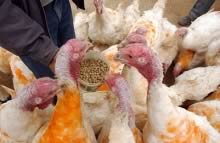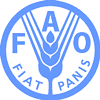 |
|||||||||
|
|||||||||||||||||||
|
|
H1N1 Flu in Turkeys May Spread 2009-08-27 The detection of an H1N1 virus in turkeys in Chile raises concern that poultry farms elsewhere in the world could also become infected with the pandemic flu virus currently circulating in humans, FAO said today.
Chilean authorities reported on 20 August that the pandemic H1N1/2009 virus was present in turkeys in two farms near the seaport of Valparaiso, Chile. The flu strain found in the poultry flocks is identical to the H1N1/2009 pandemic strain currently circulating among human populations around the world. No threat to humans However, the discovery of the virus in turkeys does not pose any immediate threat to human health and turkey meat can still be sold commercially following veterinary inspection and hygienic processing. “The reaction of the Chilean authorities to the discovery of H1N1 in turkeys — namely prompt reporting to international organizations, establishing a temporary quarantine, and the decision to allow infected birds to recover rather than culling them — is scientifically sound,” said FAO’s interim Chief Veterinary Officer, Juan Lubroth. “Once the sick birds have recovered, safe production and processing can continue. They do not pose a threat to the food chain,” said Lubroth. Disease monitoring The current H1N1 virus strain is a mixture of human, pig and bird genes and has proved to be very contagious but no more deadly than common seasonal flu viruses. However, it could theoretically become more dangerous if it adds virulence by combining with H5N1, commonly known as avian flu, which is far more deadly but harder to pass along among humans. “Chile does not have H5N1 flu. In South-East Asia where there is a lot of the virus circulating in poultry, the introduction of H1N1 in these populations would be of a greater concern,” said Lubroth. This is one reason why FAO encourages improved monitoring of health among animals and ensuring that hygienic and good farming practice guidelines are followed, including protecting farm workers if animals are sick and not allowing sick workers near animals. “We must monitor the situation in animals more closely and strengthen veterinary services in poor and in-transition countries. They need adequate diagnostic capability and competent and suitably resourced field teams that can respond to emergency needs," Lubroth said. This phenomenon is called genetic reassortment or recombination — which may happen in case of simultaneous viral infections of any of the hosts. This is now the fourth country that is investigating the spill-over of H1N1/2009 virus from farm workers showing flu-like illness to animals, with swine becoming infected in Canada, Argentina and, most recently, Australia. Even though the clinical infections in pigs and turkeys so far observed have been generally mild, it is important to bear in mind that the establishment of pandemic H1N1 virus in pig and poultry farms has the potential to bring about negative economic consequences such as trade related restrictions and misguided perceptions of the quality and safety of meat products, according to FAO. The emergence of new influenza virus strains capable of affecting humans and domestic animals remains a broader, more general concern that is being closely monitored by FAO, the World Organisation for Animal Health (OIE) and the World Health Organization (WHO).
|
||||||||||||||||||

|
|
||||||||||||||||||
| home | agri-services | pedigree
pen | news | dairy | beef | machinery property | organisations | site map |
|||||||||||||||||||

